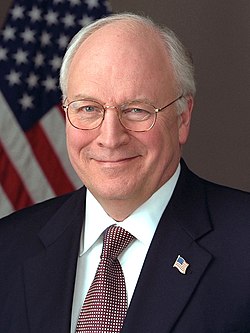Top Qs
Timeline
Chat
Perspective
List of vice presidents of the United States
From Wikipedia, the free encyclopedia
Remove ads
The vice president of the United States is the second-highest officer in the executive branch of the United States federal government after the president of the United States.[1] The vice president also serves as the president of the Senate and may choose to cast a tie-breaking vote on decisions made by the Senate. Vice presidents have exercised this latter power to varying extents over the years.[2] Two vice presidents—George Clinton and John C. Calhoun—served under more than one president.

The incumbent vice president is JD Vance, who assumed office as the 50th vice president on January 20, 2025.[3][4]
There have been 50 U.S. vice presidents since the office was created in 1789. Originally, the vice president was the person who received the second-most votes for president in the Electoral College. But after the election of 1800 produced a tie between Thomas Jefferson and Aaron Burr, requiring the House of Representatives to choose between them, lawmakers acted to prevent such a situation from recurring. The Twelfth Amendment was added to the Constitution in 1804, creating the current system where electors cast a separate ballot for the vice presidency.[5][2]
The vice president is the first person in the presidential line of succession—that is, they assume the presidency if the president dies, resigns, or is impeached and removed from office.[6] Nine vice presidents have ascended to the presidency in this way.[a] Also, several vice presidents have gone on to be elected as president in their own right.[b]
Before adoption of the Twenty-fifth Amendment in 1967, an intra-term vacancy in the office of the vice president could not be filled until the next post-election inauguration. Several such vacancies occurred: seven vice presidents died, one resigned and eight succeeded to the presidency. This amendment allowed for a vacancy to be filled through appointment by the president and confirmation by both chambers of Congress. Since its ratification, the vice presidency has been vacant twice (both in the context of scandals surrounding the Nixon administration) and was filled both times through this process.[2] The amendment also established a procedure whereby a vice president may, if the president is unable to discharge the powers and duties of the office, temporarily assume the powers and duties of the office as acting president.[7] Three vice presidents have briefly acted as president under the 25th Amendment: George H. W. Bush on July 13, 1985; Dick Cheney on June 29, 2002, and on July 21, 2007; and Kamala Harris on November 19, 2021.
Remove ads
Vice presidents
Summarize
Perspective
Remove ads
See also
Notes
- Eight (John Tyler, Millard Fillmore, Andrew Johnson, Chester A. Arthur, Theodore Roosevelt, Calvin Coolidge, Harry S. Truman, and Lyndon B. Johnson) through the president's death and one (Gerald Ford) through the president's resignation.
- Four (John Adams, Thomas Jefferson, Martin Van Buren, George H. W. Bush) were the incumbent vice president at the time of their election, while two (Richard Nixon and Joe Biden) were elected president after the end of their tenure as vice president.
- Due to logistical delays, John Adams assumed the vice presidency 1 month and 17 days after the March 4, 1789, scheduled start of operations of the new government under the Constitution. As a result, his first term was only 1,413 days long, and was the shortest term for a U.S. vice president who served a full term.
- Pro-Administration is a contemporary term for the supporters of the political and economic policies of the Washington administration prior to the formation of the Federalist and Democratic–Republican parties.
- Prior to ratification of the Twenty-fifth Amendment, February 10, 1967, an intra-term vacancy in the vice presidency could not be filled.
- Lincoln formed a bipartisan electoral alliance with War Democrats by selecting Democrat Andrew Johnson as his running mate, and running on the National Union Party ticket. Later, while president, Johnson tried and failed to build a party of loyalists under the National Union banner. Near the end of his presidency, Johnson rejoined the Democratic Party.
- Vice presidential confirmation by the United States Congress, rather than a direct election.
Remove ads
References
Works cited
Wikiwand - on
Seamless Wikipedia browsing. On steroids.
Remove ads


















































